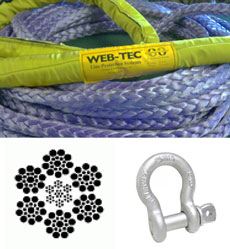When shopping for wire ropes or rigging supplies, you will quickly find that there are many options available. For many, the amount of variations causes choice overload, which means that shopping takes longer and is more frustrating. How do you know which ropes are right for your application? Learning about variations in rope types helps to make shopping more simplistic and fruitful.
One important thing to understand is the differences between 7x19, 7x7, and 1x19 wire rope design, which are three of the most common classifications a person will come across.
Wire rope specifications are typically classified by the total numbers of wires used in each strand plus the number of strands for the whole rope. The simplified system identifies cable by a pair of numbers, such as 1x19. The first number indicates the number of strands in a rope (in this case, there is one strand used). The second number represents the amount of wire used in each individual strand (19 wires).
Although the second number is typically indicative of the total number of wires in the strand, some claim it is more accurate to say it identifies the range of value and class. It is important to remember that this isn’t an exact measurement.
1x19: used when engineers need freedom when designing a stiffer cable that does not bend or flex. This rope is commonly used when running ropes in a straight line, like for guy wires.
7x7: construction crews regularly use this rope design for dealing with towing and maneuvering heavy objects. This rope is used when medium flexibility is needed.
7x19
7x19: heavy applications call for these ropes. They can handle a lot of stress before breaking. This rope offers the most flexibility when compared to the other two types.
Wire Rope